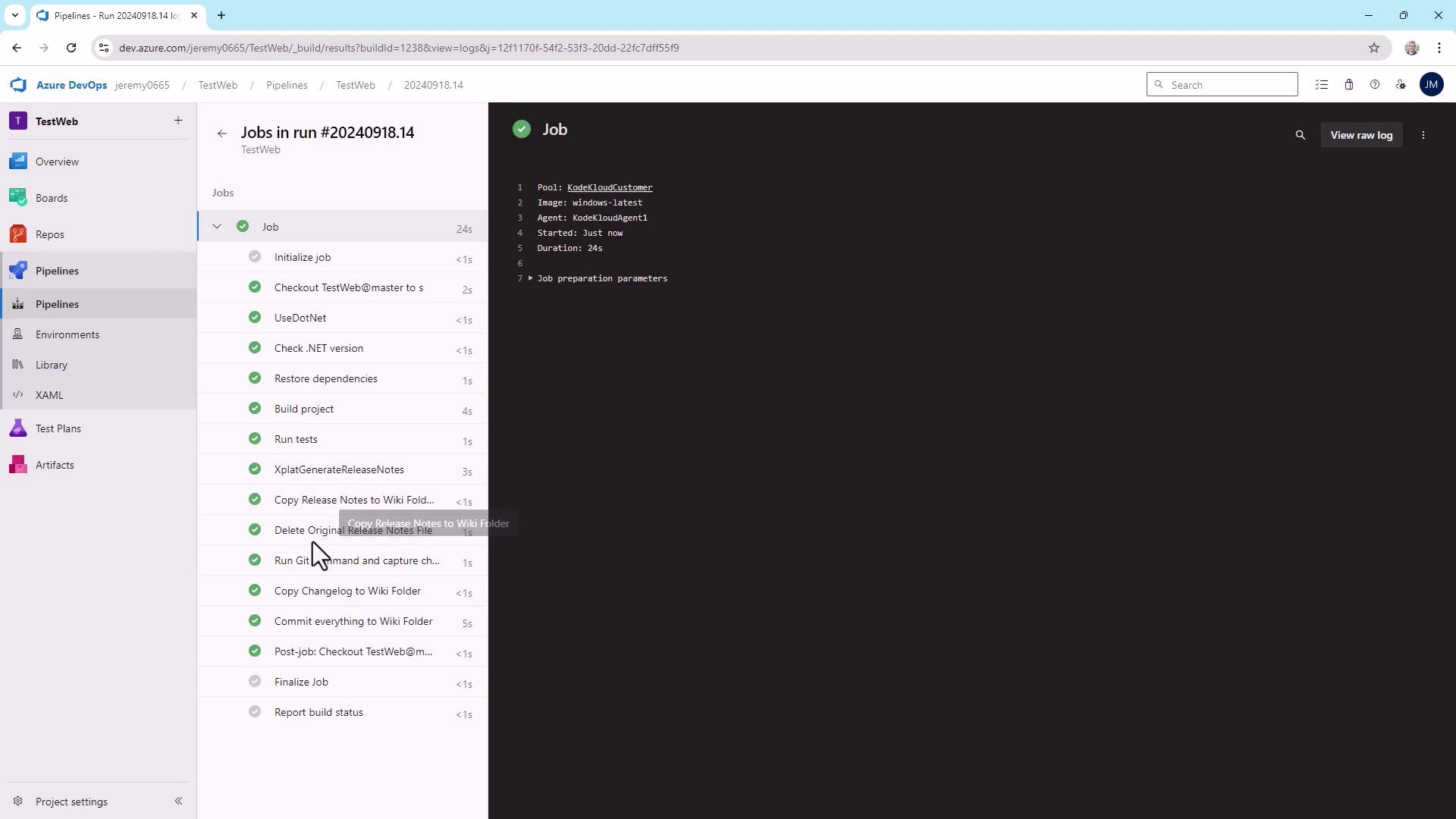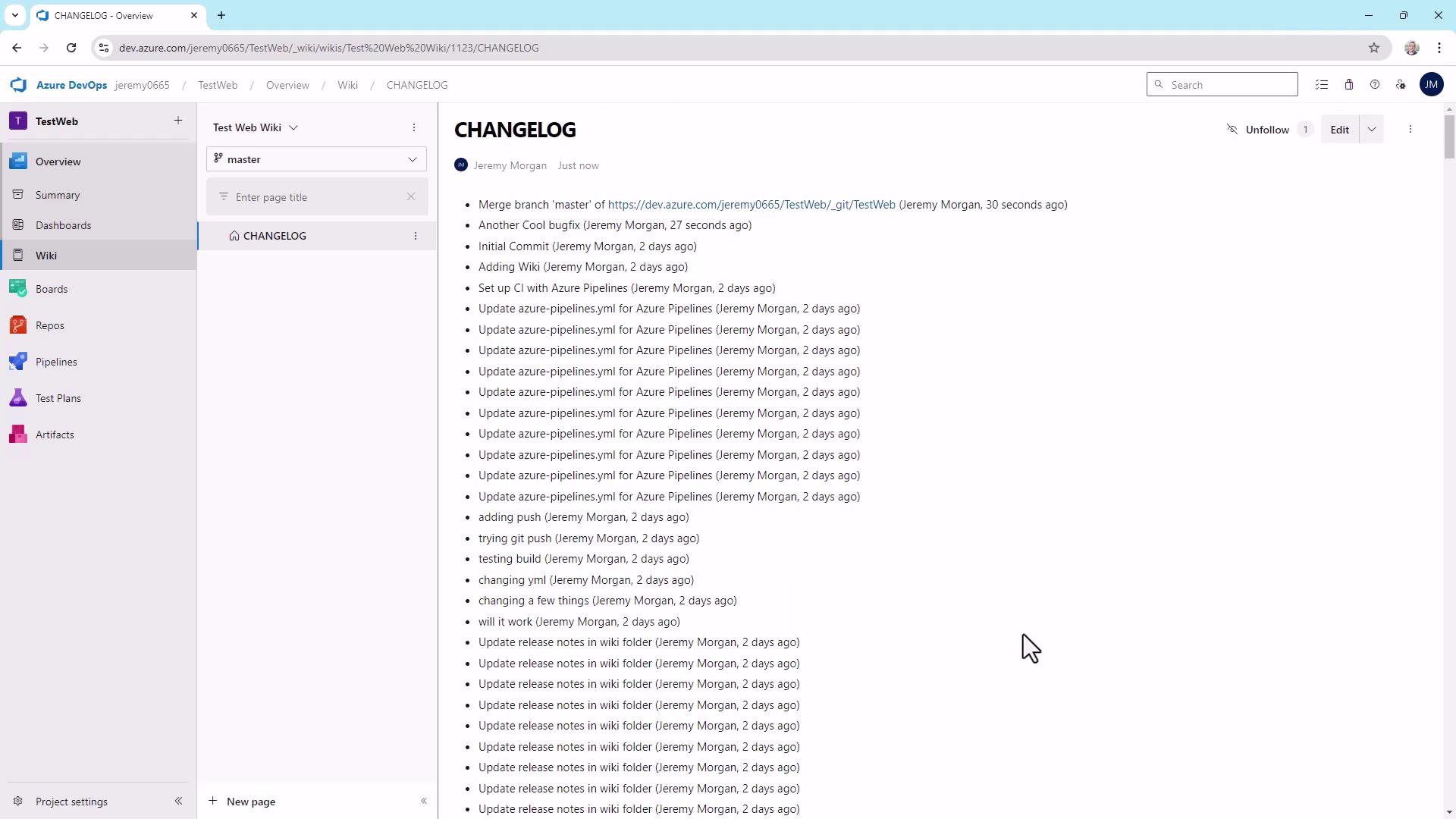AZ-400: Designing and Implementing Microsoft DevOps Solutions
Branching Strategies for Source Code
Generating a Change Log
Maintaining a clear, up-to-date changelog is essential for tracking project history and communicating updates. In this guide, you’ll learn how to automate changelog generation with Git and Azure Pipelines, then publish it directly to your Azure DevOps Wiki.
1. Quick Git Log Examples
Start by extracting commit history in chronological order:
git log --pretty=format:"%s" -s --reverse
Example output:
- Initial Commit
- Adding Wiki
- Set up CI with Azure Pipelines
- Update azure-pipelines.yml for Azure Pipelines
- adding push
- trying git push
- testing build
- changing yml
- changing a few things
- will it work
- Update release notes in wiki folder
To include author and relative date, adjust the format string:
git log --pretty=format:"%s - %an, %ar" --reverse
Sample entries:
Initial Commit - Alice, 2 years ago
Adding Wiki - Bob, 2 years ago
Set up CI with Azure Pipelines - Carol, 1 year ago
...
Git Log Format Options
| Placeholder | Description |
|---|---|
| %h | Abbreviated commit hash |
| %s | Commit subject (message) |
| %an | Author name |
| %ar | Author date, relative (e.g. “2 days ago”) |
For a full list of placeholders, see the Git log documentation.
2. Integrating with Azure Pipelines
2.1 Generating Release Notes
If you’re already using the Generate Release Notes task in your azure-pipelines.yml, it might look like this:
# azure-pipelines.yml (excerpt)
- task: XplatGenerateReleaseNotes@4
inputs:
checkForManuallyLinkedWI: False
wiqlFromFile: 'WorkItems'
- task: CopyReleaseNotes@2
displayName: 'Copy Release Notes to Wiki Folder'
inputs:
SourceFolder: '$(Build.Repository.LocalPath)'
Contents: 'releasenotes_$(Build.BuildId).md'
TargetFolder: '$(Build.Repository.LocalPath)/wiki'
CleanTargetFolder: true
OverWrite: true
- script: |
del "$(Build.Repository.LocalPath)\releasenotes_$(Build.BuildId).md"
displayName: 'Delete Original Release Notes File'
- task: CmdLine@2
displayName: 'Commit Release Notes to Wiki Folder'
inputs:
script: |
git checkout master
git pull
git config --global user.email "[email protected]"
git config --global user.name "Jeremy Morgan"
git remote add origin https://[email protected]/jeremy0665/TestWeb/_git/TestWeb
git add wiki/releasenotes_$(Build.BuildId).md
git commit -m "[skip ci] Update release notes for $(Build.BuildId) in wiki folder"
git push origin HEAD:master
2.2 Adding an Automated Changelog Task
Append a PowerShell step to generate CHANGELOG.md via git log, then copy and commit it:
# azure-pipelines.yml (extended excerpt)
- task: PowerShell@2
displayName: 'Generate CHANGELOG.md via Git'
inputs:
targetType: 'inline'
script: |
# Generate changelog with hash, subject, author, and relative date
git log --pretty=format:"%h - %s (%an, %ar)" --reverse |
ForEach-Object { Add-Content -Path CHANGELOG.md -Value $_ }
- task: CopyFiles@2
displayName: 'Copy Changelog to Wiki Folder'
inputs:
SourceFolder: '$(Build.Repository.LocalPath)'
Contents: 'CHANGELOG.md'
TargetFolder: '$(Build.Repository.LocalPath)/wiki'
CleanTargetFolder: true
OverWrite: true
- task: CmdLine@2
displayName: 'Commit Changelog to Wiki'
inputs:
script: |
git checkout master
git pull
git config --global user.email "[email protected]"
git config --global user.name "Jeremy Morgan"
git add wiki/CHANGELOG.md
git commit -m "[skip ci] Update CHANGELOG.md for $(Build.BuildId)"
git push origin HEAD:master
3. Running the Pipeline
Note
During execution, tasks run in sequence: job initialization, code checkout, dependency restore, build, release note generation, changelog creation, and file copying.

After the “Copy Changelog to Wiki Folder” step, the logs will confirm file operations:
Starting: Copy Changelog to Wiki Folder
=====================================================
Task : Copy files
Description : Copy files from a source folder to a target folder using patterns matching file paths (not folder paths)
Version : 2.238.0
Author : Microsoft Corporation
Help : https://docs.microsoft.com/azure/devops/pipelines/tasks/utility/copy-files
=====================================================
found 1 files
Cleaning target folder: C:\agent\_work\5\wiki
Copying C:\agent\_work\5\CHANGELOG.md to C:\agent\_work\5\wiki\CHANGELOG.md
Finishing: Copy Changelog to Wiki Folder
4. Viewing the Changelog in the Wiki
Note
After pipeline completion, navigate to your Azure DevOps Wiki to see the updated CHANGELOG.md listing all recent commits automatically.

5. Further Customization
You can enrich your automated changelog by:
- Including build numbers or branch names in each entry
- Linking Pull Requests or work items (
%B,%Dplaceholders ingit log) - Appending test results or code coverage summaries
Experiment with --pretty=format to tailor the output for your team’s workflow and documentation standards. Happy changelogging!
References
Watch Video
Watch video content